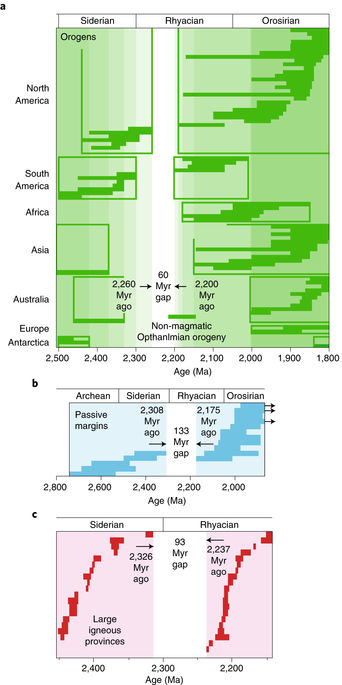Nature Geoscience ( IF 15.7 ) Pub Date : 2018-01-29 , DOI: 10.1038/s41561-017-0051-y Christopher J. Spencer , J. Brendan Murphy , Christopher L. Kirkland , Yebo Liu , Ross N. Mitchell

|
The geologic record exhibits periods of active and quiescent geologic processes, including magmatism, metamorphism and mineralization. This apparent episodicity has been ascribed either to bias in the geologic record or fundamental changes in geodynamic processes. An appraisal of the global geologic record from about 2.3 to 2.2 billion years ago demonstrates a Palaeoproterozoic tectono-magmatic lull. During this lull, global-scale continental magmatism (plume and arc magmatism) and orogenic activity decreased. There was also a lack of passive margin sedimentation and relative plate motions were subdued. A global compilation of mafic igneous rocks demonstrates that this episode of magmatic quiescence was terminated about 2.2 billion years ago by a flare-up of juvenile magmatism. This post-lull magmatic flare-up is distinct from earlier such events, in that the material extracted from the mantle during the flare-up yielded significant amounts of continental material that amalgamated to form Nuna — Earth’s first hemispheric supercontinent. We posit that the juvenile magmatic flare-up was caused by the release of significant thermal energy that had accumulated over some time. This flux of mantle-derived energy could have provided a mechanism for dramatic growth of continental crust, as well as the increase in relative plate motions required to complete the transition to modern plate tectonics and the supercontinent cycle. These events may also be linked to Palaeoproterozoic atmospheric oxygenation and equilibration of the carbon cycle.
中文翻译:

古元古代构造-岩浆平静是超大陆周期的潜在触发因素
地质记录显示出活跃和静止的地质过程,包括岩浆作用,变质作用和成矿作用。这种明显的流行被归因于地质记录的偏见或地球动力学过程的根本变化。对大约2.3到22亿年前的全球地质记录进行的评估显示,古元古代的构造-岩浆平静。在此期间,全球范围内的大陆岩浆活动(成岩和弧状岩浆活动)和造山活动减少。还缺乏被动边缘沉降,并且相对板块运动得到抑制。镁铁质火成岩的全球汇编表明,这一岩浆静止期在大约22亿年前因幼年岩浆作用爆发而终止。震荡后的岩浆爆发与之前的此类事件不同,因为爆发过程中从地幔中提取的物质产生了大量的大陆物质,这些物质合并形成了Nuna(地球上第一个半球超大陆)。我们认为,青少年岩浆爆发是由于一段时间内积累的大量热能释放所致。这种来自地幔的能量通量可能为大陆壳的急剧增长以及完成向现代板块构造的过渡和超大陆循环所需的相对板块运动的增加提供了一种机制。这些事件也可能与古元古代大气氧合作用和碳循环的平衡有关。









































 京公网安备 11010802027423号
京公网安备 11010802027423号